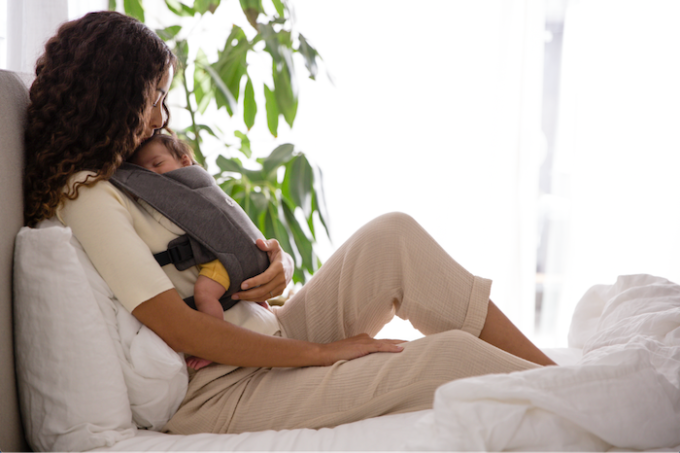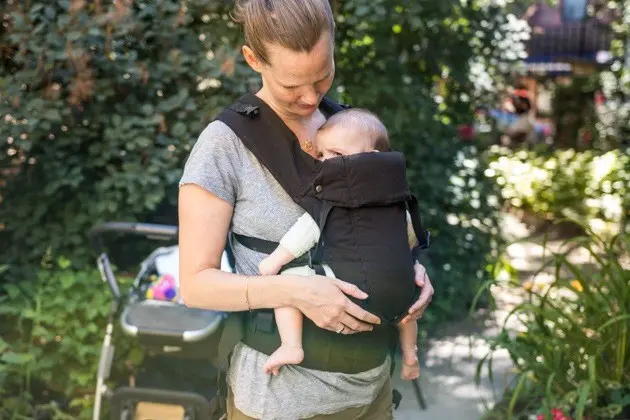Many parents rely on baby carriers for convenience and bonding, but how long is too long? Pediatricians often recommend giving your little one regular breaks to ensure healthy growth. While carriers offer a cozy, close-contact experience, babies also need time to stretch, move freely, and regulate their body temperature.
Choosing a high-quality baby carrier designed for proper hip support can make a significant difference in comfort and safety.
Key Points
- Limit continuous carrying to 1-2 hours at a time.
- Watch for cues of discomfort or overheating.
- Allow plenty of tummy time and free movement.
- Ensure proper positioning for spinal and hip health..
- Adjust based on age, weight, and needs.
Signs It’s Time for a Break

baby carrier
Carriers create a snug, secure environment, but babies will signal when they need a change. Paying close attention to their reactions helps prevent discomfort and potential health concerns.
- Squirming or fussiness – Indicates that your baby is ready for a different position or a movement break.
- Excessive sweating – A sign that your baby may be too warm, requiring cooler clothing or a rest period.
- Red marks on the skin – Pressure points from straps or fabric may suggest the fit needs adjusting.
- Stiff or tense posture – Lack of flexibility may lead to discomfort, requiring repositioning.
- Falling asleep in awkward positions – A proper ergonomic hold supports healthy breathing and spine alignment.
If any of these signs appear, it’s best to switch to a stroller, floor play, or gentle holding to provide relief.
How Long is Too Long?
Experts suggest limiting continuous carrier use to 1-2 hours at a time. This timeframe prevents overheating, pressure on developing joints, and restrictions on natural movement. Older infants may tolerate longer stretches, but scheduled breaks remain essential.
Best Positions for Safety and Comfort
Each stage of development requires an adjusted carrying position to support healthy posture and comfort.
- Newborns (0-3 months): Upright positioning is essential, with full head and neck support to prevent strain.
- Three to six months: Babies gain better head control, allowing for a slightly more open posture. Hip-friendly positioning remains crucial.
- Six months and beyond: A back-carry position can help distribute weight evenly, reducing strain on the parent’s body.
Ensuring proper leg positioning with a deep seat and knees higher than the bottom prevents discomfort and supports hip development.
Should You Let a Baby Nap in a Carrier?

Source:facebook.com
Many babies naturally fall asleep in a carrier, lulled by movement and warmth. While short naps are generally safe, close supervision is essential.
- Ensure an open airway. Keep your baby’s chin off their chest to prevent breathing difficulties.
- Check for overheating. Damp skin or flushed cheeks signal a need for cooling measures.
- Limit extended naps in a carrier. Transition to a crib or bassinet for longer sleep sessions.
For safe napping, parents should remain attentive and periodically adjust their baby’s position.
How to Avoid Overheating
Carriers can trap body heat, making temperature regulation important.
- Dress lightly in warm weather. Choose breathable fabrics and remove extra layers if needed.
- Monitor skin temperature. A warm or damp back may indicate overheating.
- Take breaks in shaded areas. If outdoors, avoid direct sunlight for extended periods.
- Use a carrier with airflow panels. Mesh or ventilated fabrics help regulate body heat.
Keeping your baby cool ensures a comfortable, safe experience, especially in warmer climates.
Age-Specific Guidelines for Carrier Use
Each stage of development calls for adjusted carrying habits.
Newborns to Three Months
Newborns have delicate necks and developing hips, requiring extra support.
- Limit carrier use to short periods. Frequent breaks promote unrestricted movement.
- Ensure proper airflow. Keep fabric away from their face and maintain a secure, upright position.
- Prioritize skin-to-skin contact. It’s beneficial for bonding but should be monitored for comfort.
Four to Six Months
Babies start gaining strength and need gradual adjustments in positioning.
- Gradually extend carrying time. Observe comfort levels and adjust as needed.
- Introduce different positions. Side-carrying or a slightly forward-facing position may add variety.
- Alternate between carrier time and tummy time. Floor activities help strengthen muscles.
Six Months and Older
Older babies become more active and need increased floor time for mobility development.
- Allow for more exploration outside of the carrier. Encourage crawling and standing.
- Use a variety of carrying styles. A back carry may ease the strain on your body.
- Ensure legs are in the proper “M” position. Hip-friendly posture prevents discomfort.
Tips to Make Babywearing More Comfortable
- Use a well-padded carrier. Shoulder and waist support help distribute weight evenly.
- Adjust the fit frequently. Growth and clothing layers may require modifications.
- Watch for signs of discomfort. If your baby seems restless, a break may be necessary.
- Switch sides regularly. If using a sling, alternate carrying sides to prevent strain.
- Engage in gentle movement. Rocking or swaying helps maintain a calming environment.
Common Mistakes to Avoid
Avoiding common errors ensures safety and comfort for both parent and baby.
- Straps too tight or too loose. A snug but flexible fit is key.
- Overuse without breaks. Regular movement outside of the carrier is necessary.
- Incorrect leg positioning. Knees should be higher than the hips to support healthy joint development.
- Ignoring baby cues. Fussiness or resistance often signals the need for a break or repositioning.
When to Stop Using a Carrier
Most carriers support up to 35 pounds, but every parent’s comfort level differs. Many transition away from carriers when their child starts walking, but others continue for convenience and bonding.
- Monitor weight limits. Exceeding capacity affects safety.
- Assess mobility. Walking and independence may reduce the need for carrying.
- Consider personal comfort. Strain on the back or shoulders may indicate a need to phase out use.
Conclusion

Source: nytimes.com
Baby carriers provide a secure and practical way to keep your little one close, but moderation is key. Pay attention to signals, take breaks, and choose a design that promotes hip health. Adjust positioning based on age and mobility, ensuring a balance between cozy snuggles and independent movement.



